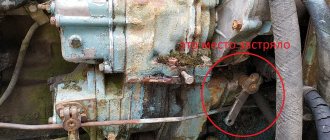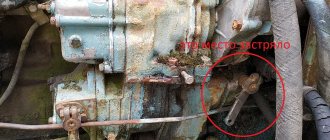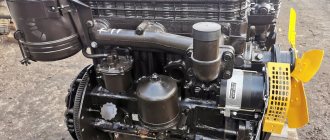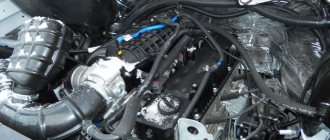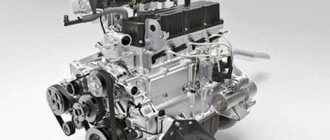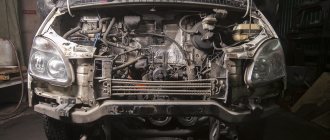Author: Sochi Auto Repair
No matter how many horses there are under the hood of a car, they are never enough. Although the power of the ZMZ 406 injection engine according to the technical data sheet is 145 hp. p., this is not enough for all car owners.
Today we will tell you about increasing the power of the ZMZ 406 engine with an injector.
Cars that have a 406 engine are usually heavy, therefore, to ensure good dynamics, they need a suitable power unit.
What are the ways to increase the power of the ZMZ-406 injector?
Increasing the power of the ZMZ 406 engine
Maximum boring of the cylinders can only harm the power unit and reduce its service life.
In general, a complete engine overhaul and installation of lighter weight pistons and a lighter crankshaft is an expensive proposition. Of course, the best option is to install a turbine on the engine.
Compared to other methods of increasing power, a turbine causes less damage to the power unit.
When used on the ZMZ-406, it will be possible to increase the engine power to 200 hp. In addition, today there are different types of turbochargers that are easy to install and do not require special attention from car owners.
Mechanical supercharging ZMZ-406
Increasing the power of the ZMZ 406 engine by mechanical supercharging.
All types of compressors can be divided into 2 large groups: mechanically supercharged and turbocharged. Both of these types have their pros and cons, and they also have their fans and opponents.
What type of compressor is best to use for the ZMZ-406 engine? And what is mechanical supercharging anyway?
The operating principle of mechanical supercharging is quite simple. Its design resembles an oil pump. It consists of two axes on which gears with teeth in mesh are located.
By analogy with the ZMZ-406 oil pump, which creates pressure in the lubrication system, the compressor creates air pressure. The compressor is driven by the crankshaft of the engine.
Mechanical supercharging has several disadvantages. The most important is the significant reduction in efficiency due to the use of the crankshaft to drive the compressor, which leads to increased load on the engine.
Due to the high pressure after the compressor, the likelihood of air leaking back increases. To prevent this from happening, a multi-stage air supply is used with several pumps installed one after the other. However, this leads to a more complex and expensive design.
Turbocharging ZMZ-406
Increasing the power of the ZMZ 406 engine by turbocharging. The best performance for the ZMZ-406 injector is shown by turbocharging.
It does not have any belt drive from the crankshaft, and its design is much more reliable, cheaper and more unpretentious.
The operating principle of turbocharging is extremely simple: inside the exhaust manifold there is an impeller driven by exhaust gases, and the number of revolutions of the turbine can exceed more than 200 thousand.
The turbine and air blower are located on the same axis along with the impeller, inside the exhaust manifold.
That is, the injection engine does not need to waste energy spinning up the compressor, due to which its efficiency does not decrease, but, on the contrary, increases.
Specifications and description
Structurally simple and easy to maintain, the 406 engine was an excellent power unit. Increased power and reduced fuel consumption allowed the power unit to blend harmoniously into the cars. In addition to the vehicles of the Gorky Automobile Plant, the 406 engine was mounted on the UAZ.
The first generation of the 406 engine had a carburetor injection system, but with the widespread arrival of the injector, it was decided to improve the engine and adapt it to distributor injection.
So, let's look at what technical characteristics the 406 engine has:
| Name | Characteristic |
| Type | Row |
| Fuel | Petrol |
| Injection system | Carburetor, later injector |
| Volume | 2.3 liters (2280 cm3) |
| Power | 145 horsepower |
| Number of cylinders | 4 |
| Number of valves | 16 |
| Cylinder diameter | 92 mm |
| Consumption | 11 liters per 100 km |
| Cooling system | Liquid, forced |
| Cylinder operating order | 1-3-4-2 |
| Motor weight | 185 kg (for some modifications 187 kg) |
Also, the Volga region produced a forced engine - ZMZ 40620D. On many vehicles, the letter D means that the power unit is classified as a diesel engine, but in the case of our factories the situation is different - it is a designation of power.
Let's look at the technical characteristics of the ZMZ 40620D engine:
| Description | Parameter |
| Type | Row |
| Fuel | Petrol |
| Injection system | Injector |
| Volume | 2.3 liters (2280 cm3) |
| Power | 145 horsepower |
| Number of cylinders | 4 |
| Number of valves | 16 |
| Cylinder diameter | 92 mm |
| Consumption | 11 liters per 100 km |
| Cooling system | Liquid, forced |
| Cylinder operating order | 1-3-4-2 |
As you can see, the only difference is the amount of horsepower. Other indicators do not change.
All cars were equipped with a 5-speed manual transmission. The design of the ZMZ 406 engine is simple. Unlike its predecessor, the 402, this power unit featured two camshafts and 16 valves. The ignition system has also been adapted. The engine life has increased to 250,000 km, instead of 150,000 km.
In addition to the standard motor, there are also a number of modifications. Modified 406 engine and characteristics:
- ZMZ 4061.10 - carburetor engine, SZh 8 for 76 gasoline. Used on Gazelles.
- ZMZ 4062.10 - injection engine. The main modification is used on Volgas and Gazelles.
- ZMZ 4063.10 - carburetor engine, SZh 9.3 for 92nd gasoline. Used on Gazelles.
This is interesting: TD27T - engine specifications
Which engine to choose - carburetor or injection
Many car owners are increasingly attracted to the injection version of the power unit instead of the usual carburetor model. The Gazelle 406 injection engine is increasingly being installed on heavy vehicles.
The Zavolzhsky Automobile Plant equips cars such as the Volga, UAZ, and Gazelle with more powerful injection engines. These brands of cars require increased power; a gasoline power unit of this type is capable of developing as much horsepower as is required for their stable operation.
Main differences and technical characteristics
ZMZ-406 is an in-line four-cylinder engine. Its main part is a cylinder block made of gray cast iron.
Disassembled motor ZMZ 406
It is heavier than aluminum, but has increased rigidity and does not require replaceable sleeves. The engine design has changed significantly compared to the previous model (ZMZ-402). An important feature is that the cylinder head contains two camshafts, one of which is intended for the intake valves, the other for the exhaust valves. They are driven by a two-stage chain, with hydraulic tensioners operating in automatic mode.
Each cylinder has four valves to improve the intake of the working mixture and the exhaust of exhaust gases. The valves are actuated by hydraulic pushers and do not require clearance adjustment. The spark plugs are located in the center of the combustion chambers, which increases the compression ratio.
Basic technical data of ZMZ-4062.10:
Comparison of technical characteristics of various modifications of the ZMZ-406 engine
- Weight, kg - 192;
- Volume, liters - 2.28;
- Compression ratio - 9.3 (8*);
- Power, l. With. - 145; 100*; 110**;
- Torque, Nm - 200.9; 181.5*; 191.3**;
- Gasoline brand - AI-92, A-76*;
- Oil volume, liters - 6;
- Coolant volume, liters - 10.5.
Engine 4216. UMZ-4216. Specifications
Nowadays, popular and widespread commercial vehicles of the GAZ brand are equipped with UMZ engines produced at the Ulyanovsk Motor Plant.
A little history
The Ulyanovsk Motor Plant dates back to 1944, and only in 1969 the company produced the first UMZ brand engine. Until 1969, the plant was engaged in the production of small-displacement engines UMZ-451 and their components.
Since the release of the first engine, they have faithfully served on trucks, off-road vehicles, and small buses. In 1997, AvtoGAZ became the main consumer of engines, which equipped most models of the GAZelle line with UMZ units.
Design features
At the moment, there is a wide range of internal combustion engines from the UMZ model range, which are installed on different models of Sobol, UAZ, GAZelle cars. The installed engines have a number of common features, but may differ in some details and operating principles:
- Carburetor and injection.
- Four-cylinder in-line.
- Power 89-120 l. With.
- Environmental standards “Euro-0”, “Euro-3”, “Euro-4”.
All engines are lightweight, small-sized and reliable. They are distinguished by their affordable prices.
One of the features of the engine is the original design of the cylinder block, cast from aluminum, with pressed liners made of gray cast iron. During manufacturing, crankshafts of motors of all modifications undergo hardening of the main and connecting rod journals with high-frequency currents. A self-clamping rubber seal seals the rear of the crankshaft.
Modifications of the model range
UMZ engines have two lines of power units designed to equip various vehicles.
Cars of the GAZelle family are equipped with the following models: UMZ-4215; UMZ-4216; UMZ-42161; UMZ-42164 “Euro-4”; UMZ-421647 “Euro-4”; UMZ-42167.
The main part of the engines comes out in several variations, which differ in their configuration, power and economical indicators. At the moment, the production of units running on gasoline with an octane rating of 80 has ceased.
All engines are designed for 92 and 95 gasoline, as well as with the ability to run on gas.
This review is dedicated to the UMZ-4216 power plant; its characteristics and properties will be described in detail.
pros
The advantages of the engine rightfully include maximum torque at low speeds, excellent technical characteristics, as well as ease of maintenance of components and assemblies. Engine 4216 became the first domestic device that has a warranty period when installing gas equipment on it.
Modernization
The unit is equipped with a microprocessor system for controlling the operation of the fuel mixture injection and ignition system. The knock and oxygen sensors of the 4216 engine directly affect the operation of the integrated electronic control system and the unit as a whole. To change economic characteristics and increase competitiveness, the following design additions were made to the power plant:
- To improve performance, the compression ratio in the cylinders was increased.
- To reduce oil consumption, the crankcase gas exhaust system was modernized.
- The reliability of the motor is ensured through the use of improved parts and materials.
At the same time, the unit has not changed in terms of overall parameters and standard characteristics (working volume - 2.89 liters, piston stroke, cylinder size).
For the first time, the GAZ-4216 engine began to be equipped with imported parts, which only increased the quality of work and durability in operation. The power unit was equipped with spark plugs and fuel injectors manufactured by Bosch, as well as a throttle position sensor made in Germany.
Main malfunctions of UMP
Previously, the most common engine failure was damage to the intake manifold. According to the developers, a manifold made of fragile material was installed on the 4216 engine. But already in 2010, this shortcoming was corrected through the use of higher quality material.
A flaw was also discovered in the cooling system. At medium engine speeds and when the car was moving at a speed of 60 km/h, the coolant temperature was normal, but as soon as you slowed down or got into a traffic jam, the 4216 engine rapidly increased in temperature, until the coolant boiled. The reason lay in the electromagnetic clutch, which turned on the forced cooling fan.
Technical specifications
The engine runs on AI gasoline with octane ratings of 92 and 95. Four-cylinder, in-line, eight-valve. The cylinders have the following operating order - 1243. Its diameter is one hundred millimeters, and the piston displacement is 92 millimeters. The engine capacity is 2.89 liters, it develops a power of 123 “horses” at four thousand revolutions. The engine compression ratio is 8.8. The maximum torque is 235.7 at 2000-2500 rpm.
The GAZelle with the UMZ-4216 engine can reach a maximum speed of 140 kilometers per hour, which is a good indicator for this class of car. Fuel consumption depends on the vehicle load, driving style and road conditions, but in general it looks like this: at a speed of 90 kilometers per hour - 10.4 liters. When driving at a speed of 120 km/h – 14.9 liters.
Supply system
It consists of a fuel supply device and various fuel lines, injectors, fuel and air filters, air supply pipes and a receiver, and an idle air regulator.
Fuel supply is controlled using a variety of sensors: charge air temperature element, crankshaft and camshaft position sensors, absolute pressure part, throttle valve position.
The supply control system is also equipped with an oxygen indicator. The latter is installed in the exhaust system in front of the converter. For greater reliability and durability, the 4216 engine (injector) should run only on high-quality gasoline, taking into account regular replacement of fuel filters and periodic diagnostics of fuel equipment. Motorists say that with proper operation, the total resource of the power unit can reach 500 thousand kilometers. The injection units of the Zavolzhsky Motor Plant also have this feature (meaning the ZMZ 405 and 406 engines).
Gas distribution mechanism
In 2010, at the Ulyanovsk plant, the gasoline engine underwent the process of modernizing the gas distribution mechanism. In general, this affected the change in the camshaft cam profile, which contributed to an increase in valve stroke by one millimeter. These innovations were necessary to improve the stable operation of the unit at idle, as well as to achieve the standards and requirements of the Euro-3 standard.
The valve springs did not undergo any changes, and this led to the fact that the effective force on the springs crossed the norm and was now equal to 180 kgf. When installing a conventional set of rods on a new engine, knocking noises from the hydraulic compensators were heard before the engine was warmed up.
To prevent this problem, the spring force should be changed by removing the internal valve springs.
Advantages of booms with hydraulic compensators
The UMZ-4216 engine with hydraulic compensators does not require additional maintenance due to the absence of valve clearances throughout the entire period of operation. Due to this, the noise level is noticeably reduced. High engine speeds are no longer critical, since the design of hydraulic compensators includes a factor for stabilizing the occurrence of critical loads. The degree of wear of the mating surfaces of the mechanism parts is significantly reduced. Due to optimization of gas distribution phases, harmful impurities in exhaust gases are consistently low throughout the entire period of operation.
Crankcase ventilation
The motor is equipped with a closed crankcase cavity ventilation system. Part of the gases passing through the compression rings is discharged into the intake manifold in a combined manner. The system operates due to the pressure difference between the crankcase and the intake tract. When the 4216 engine operates under high loads, gases are vented through a special large branch.
Through the small branch, gases are removed when the unit is running at idle speed and at minimal loads.
A ventilation system draft regulator is installed in the front cover of the pusher block, which performs the function of separating oil microparticles from gases and serves to prevent dust from entering the crankcase when the draft in the intake system increases.
Oil
The engine lubrication system is of a combined type (splash and pressure). The oil that the oil pump draws from the sump passes through the oil passages into the oil filter housing. Then it enters the cavity of the second jumper of the block, and from there into the main line. The main journals of the crankshaft and camshaft receive oil from the oil line.
The connecting rod journals are lubricated by oil flowing through channels from the main bearings. This principle is used to lubricate the parts of the gas distribution mechanism.
The volume of oil poured into the engine crankcase is 5.8 liters.
Design
The 406 injection engine model is represented by an in-line 4-cylinder engine, the number of valves is 16. Fuel injection is adjusted electronically. Runs on gasoline.
Design Features:
Engine ZMZ-406 - device
- each cylinder has 4 valves;
- camshafts are located at the top of the cylinder block;
- The compression ratio is increased due to spark plugs and the injection system (9.3);
- the cylinder blocks are cast iron, more durable, unlike the aluminum ones with which the carburetor unit is equipped;
- the oil filter is improved, with additional elements;
- improved ignition system;
- parts are made of modern technological materials, their weight parameters are reduced;
- the piston stroke is reduced (86 mm);
- installation of a chain of an original design that performs the function of driving camshafts, which is equipped with hydraulic tensioning devices that operate automatically.
Disadvantages of a carburetor engine
Comparing the 406 carburetor engine with its injection analogue, one can be convinced of the noticeable superiority of the second in such indicators as power and performance. The main reason for the significant differences is the original power system. In a carburetor engine, fuel is supplied to the cylinder as the speed increases, resulting in lower power and acceleration.
A carburetor engine is less economical due to the inability to accurately regulate the gasoline supply. It is almost impossible to more accurately regulate the amount of fuel, which affects power and fuel consumption.
Despite the disadvantages described, many car owners love their carburetor engines. A car equipped with such a power unit is as reliable and durable as a proven horse can withstand the load.
List of internal combustion engine modifications
Initially, the engine was designed to be fuel-injected, so version 4062.10 is considered the basic one. The need for carburetor modifications 4061.10 and 4063.10 arose later. They were installed on Gazelle, so while maintaining the volume of the combustion chambers, it was necessary to reduce the owner’s operating costs. To do this, ZMZ management lowered the compression ratio in order to switch the engines to cheaper A-76 fuel.
Versions of the ZMZ 406 engine differ in combustion chambers
A reverse modernization was made with motors 4061 and 4063:
- reduced power and torque;
- speed XX steel 750 min
-1instead of 800 min
-1
;
- Maximum torque is achieved at 3500 rpm, rather than 4000.
Everything else mounted is located in the same places without changes. Some parts are interchangeable, with the exception of the cylinder head and piston.
Advantages and disadvantages
A negative feature of the ZMZ 406 power drive is the low quality of casting and poor technical solutions:
- high oil consumption due to unfinished ring design;
- low timing life of the drive due to the tensioner, collapsible block star and bulky design as a whole.
Fuel consumption is high, but this is typical for most truck engines.
But vibrations are reduced, the cylinder head does not unscrew during operation, the gasket does not need to be constantly changed, and the nuts do not need to be tightened. The maintainability of all components is high, the design itself is reliable and simple. The user is spared the need to adjust valve clearances every 20,000 miles.
Intake manifold injector
This is interesting: Which winter tires are better: studs or Velcro
Popular mistakes made by motorists
The pursuit of increased power for some motorists comes down to just reworking the ZMZ 406 engine. But not all modifications are good. And some are harmful, this is what reverse tuning or anti-tuning consists of:
- There are rumors on the Internet that you can increase engine power by reducing the mass of the flywheel. At the same time, the authors point out that the flywheel takes away power and increases the weight of the engine. In fact, the flywheel stores the energy that this engine receives during the “power stroke” to complete the remaining cycles in a four-stroke engine. As the number of cylinders increases, the relative mass of the flywheel decreases, but this occurs due to a change in the number of power strokes per revolution of the crankshaft, since more pistons are involved in the work. Ideally, if you increase the number of working cylinders to infinity, then the flywheel will not be needed at all.
- There are experts who recommend installing air swirlers in the intake system. But such specialists do not understand that when the air flow moves, a turbulent flow regime is observed. Turbulence by definition is a movement with an eddy flow, as Bernoulli proved more than 150 years ago. Excessive interference will only reduce the amount of air charge and reduce power, which will also affect the efficiency of the engine.
- Recently, ideas have also appeared to heat the air at the intake - they say that the 406 engine will have an injector increase in power. But this is not true. The air charge density decreases with heating and constant pressure. Consequently, its total quantity decreases. And this leads to the fact that the pressure drops during combustion of the mixture, and instead of increasing, the power decreases.
- There are also authors who have been saying for more than forty years that water should be fed droplets into the intake tract of the ZMZ 406 injector. But remember that designers are looking for ways to separate fuel and water so that the combustion process is more intense. Water entering the cylinder at high temperatures will begin to cause intense corrosion. When fuel burns, the exhaust gas contains carbon monoxide and water vapor. Those who have been using motors for quite some time know that the ZMZ 406 engine does not need to use ways that impair its reliability.
- There is also a group of “specialists” who recommend optimizing the engine by replacing the hydraulic chain tensioner. They advocate installing an electric tensioner, and the circuit diagram of the vicious device should be purchased from them for a lot of money. It’s already absurd to pay to ruin the power plant.
Therefore, when listening to the advice of various specialists, you should remember that the designers at ZMZ understand their business much better than ordinary people. It’s not for nothing that they refuse many ideas that will ruin the engine.
What is the difference between the 406 engine and the 405 engine?
Cars
What is the difference between the 406 engine and the 405 engine?
1 Dec, 2013
The 406 and 405 engine families are the real pride of ZMZ (Zavolzhsky Motor Plant), the main supplier of engines for models of the Gorky Automobile Plant. Both engines have many similarities and differences that every car enthusiast needs to know, despite the fact that one engine replaced the other. Moreover, the strong differences between the two engines concern the technical component, which is especially important.
Engine 406
The 406 engine went into mass production in 1997 (before that, prototypes were produced for five years). It was an internal combustion automobile engine running on gasoline. An important detail is that ZMZ engineers used fuel injection for the first time. For a long time, this engine was widely popular on many GAZ models, including the famous Volga (3110).
The main advantage of the engine was its high reliability and efficiency. But there were also disadvantages: problems with the cooling system were quite common. Time passed, and ZMZ representatives understood perfectly well that the 406 engine needed improvement from a technical point of view, and on its basis a new engine was developed - 405 (injector).
Engine 405
The four-cylinder fuel-injected engine 405 became a full replacement for the above-described model. He was born in 2000 in a GAZ-3111 car. Subsequently, it was the cars of the Gorky Automobile Plant that became regular consumers of the 405 engine. This engine was constantly improved: for example, the MZ-40522.10 engine was almost five percent more powerful than the base model, and its volume increased by almost eight.
Thus, the rated power of the engine reached 150 horsepower. The 405 engine is used not only in GAZ passenger models, but also in minibuses.
Comparison of 405 and 406 engines
Already from the definition it could be concluded that the main difference is that 406 is a carburetor, and 405 is an injector. However, even without this, one can count quite a few differences between the two ZMZ engines. So, what is the difference between a 405 engine and a 406:
— The 405 engine was developed later, and its main task was to replace the outdated 406 engine. In other words, 405 is a more modern and high-quality model.
— The displacement of the 406 engine is 2.28 liters, while the 405 has 2.46.
— Both engines have the same rpm - 5200. But at the same time, the power of the ZMS-405 family is more powerful - 111.8 kW, more than 150 horsepower. For comparison, the 406 engine produces 106.6 kW and 145 horsepower.
— Thanks to the 405 injector, the model has lower fuel consumption, plus the engine starts noticeably easier. Actually, this is the main advantage of this ZMZ family, thanks to which almost all GAZ cars choose them.
— The 406 engine has its advantages: for example, the carburetor is more reliable and breaks down less often. Not to say that the ZMZ-405 family is characterized by reduced reliability, but it is a fact that the 406 engine breaks down less often.
The difference between the 406 engine and the 405 is as follows:
- 406 engine - carburetor, 405 - injector.
— The 405 engine was designed to replace the 406, because there was a need for a more modern version of the engine.
— The engines have different displacements: the 405 has 2.46 liters, the 406 has 2.28.
- Despite the same number of revolutions per minute, the power of the 405 engine is higher - 150 horsepower versus 145.
— The 405 engine has lower fuel consumption and is easier to start.
— The 406 engine is more reliable and does not break down as often.
What is the difference between the 406 engine and the 405 engine?
3.8 (75%)
More from the section:
pochemu-i-kak.ru
List of car models in which it was installed
Since the ZMZ 406 engine has three versions, each of them was used on specific models of the car manufacturer GAZ:
- ZMZ 4062.10 – GAZ 31054 Luxury configuration; GAZ 3102 (1996 – 2008);
- ZMZ 4061.10 – GAZ 3302, 33023, 2705, 3221;
- ZMZ 4063.10 – GAZ 3302, 33023, 2705, 3221, 32213, 322132, 32214, SemAR 3234, Ruta, Bogdan and Dolphin.
GAZ Gazelle Farmer
In the first case, the engine characteristics were suitable for the urban cycle of executive cars of officials and governments. Carburetor modifications reduced the operating budget of Gazelle vans, utility vehicles and trucks.
Advantages
The reliability, efficiency, and power of the injection unit are significantly superior to its carburetor counterpart. Therefore, the 406 Gazelle engine is installed on such brands of cars that require higher performance indicators:
Engine 406 Gazelle
- Reliability and uninterrupted operation are ensured thanks to the design features - there are no jets, so nothing gets clogged in the power system.
- Cost-effective – the entire process is controlled electronically.
- Thanks to the timely supply of fuel in the required amount, the injection engine can develop power up to 130 hp. With. (carburetor - up to 100 hp).
- There is no idle speed.
- Significantly lower emissions of harmful substances.
The only negative is that due to the electronic adjustment system, if it breaks down during the journey, you will not be able to repair it yourself. But with careful operation, refueling with high-quality fuel, and timely maintenance, the injection engine will not cause big problems.
Carburetor characteristics
This power system is used to mix air and gasoline, as well as supply it and regulate flow. At the moment, such intake systems are not mass-produced. They have long been supplanted by the injector. A distinctive feature of the carburetor power system is the mechanical method of mixing fuel. This process took place in a separate device. It's called a carburetor (hence the name).
It has two chambers with floats. The latter are connected to the needle and interact with the jets. According to environmental standards, such engines complied with the Euro-2 standard. This is one of the reasons why such systems have not been installed on cars since 2009.
Malfunctions and repairs
Since the new power unit was made on the basis of the old 406, the problems and repairs remained the same. Thus, the main malfunctions that occur in the ICE 405 include: frequent breakdowns of the cooling system associated with poor performance of the thermostat, tripping, floating speed and poor starting.
It is recommended that for ZMZ 405 repairs be carried out in a car service center, since it is not always possible to determine the breakdown. This is due to a malfunction when the ZMZ 405 starts and stalls. In this case, the problem may be hidden in the spark plugs or the electronic engine control unit. If the malfunction is mechanical in nature, then it is easy to fix it yourself, but if the problem is in the ECU or sensors, then you will have to make a trip to a car service center.
"Gazelle-405" (engine injector): characteristics, repair and operation
The Gazelle-405 car, whose engine-injector uses an injection system that allows efficient consumption and distribution of the fuel mixture throughout the system, is used in cargo and passenger transportation. The design of the power unit differs from its predecessor in the presence of 16 valves. This motor belongs to the ZMZ series produced by the Zavolzhsky plant.
How does an injection engine work?
The operating principle of an injection engine is to supply fuel through injectors controlled by an electronic control unit (ECU). The controller monitors the state parameters of the power plant, calculates the need for supply and quantity of fuel, and provides adjustments to the fuel supply using the pulse duration.
The ECU is able to evaluate the results of calculations and commands, as well as remember previously performed manipulations, coordinating further actions with it. The process of intellectual development of the unit occurs continuously and lasts throughout the entire period of operation of the car. Fuel supply in the Gazelle-405 car (engine injector) can be carried out in two ways:
- Synchronous version - with a fixed crankshaft position.
- Asynchronous feed - independent of crankshaft rotation.
The first method is preferable. Asynchronously, fuel is usually supplied when the power unit starts. The injectors are operated in pairs or alternately.
Characteristics
The injection engine in the Gazelle Business car has the following technical characteristics:
- Engine type is a four-stroke gasoline unit with 4 cylinders.
- Injection system - microprocessor controlled with ignition and air supply.
- Cylinder volume (cubic cm) – 2,464.
- Standard power at a rotation speed of 4.5 thousand revolutions is 214 Nm.
- The filter is an air dry replaceable element.
- The cooling system is closed type with forced circulation.
- Generator – with a built-in unit and voltage controller.
- Sensors for monitoring system overheating and oil pressure.
- The starter is a remote, electromagnetic version with a gearbox.
Technically, the 2.46-liter engine with a power of 140 horsepower allows the car to overtake or perform sharp maneuvers when fully loaded.
Powertrain capabilities
Owners of the Gazelle-405 car are impressed by the fuel-injector engine, especially in terms of fuel consumption. It ranges from 8 liters on the highway to 13 in the combined cycle when driving around the city. Oil is also used sparingly: approximately 100 grams per thousand kilometers. In a single-point system, the manifold is equipped with only one injector for all cylinders. In a distributed block, each of them has its own collector. And with direct injection, fuel is supplied directly to the cylinders, just like a diesel engine.
Injection cars are more economical, as precise dosing occurs. In addition, the environmental friendliness of the exhaust gases released into the environment complies with the Euro 3 standard, and the power indicator increases by 10%.
This power unit is adapted to domestic climatic conditions. It tolerates heat, extreme cold and sudden temperature fluctuations well. The power plant functions clearly and reliably in the most severe and difficult climatic zones. It starts without problems in severe frost.
Malfunctions and their elimination
Like any technical product, the Gazelle-Business motor is susceptible to breakdowns. Sometimes it needs repairs for various reasons. The most common problems that arise are:
- The motor does not start. Most likely there is no fuel supply to the injectors. It is necessary to use the appropriate fuel, rinse and clean the fuel intake.
- The tightness of the pipeline between the tank and the electric pump is broken. The connection points should be checked and the tightness restored.
- There are problems with the control electronics. It is necessary to replace faulty parts of the unit.
- Poor power delivery indicates problems in the electronic control system. After testing, it is necessary to replace the unusable element.
- The fine filter is clogged. In this case, the filter element must be replaced.
- Air appears in the fuel block. It is necessary to check and ensure the tightness of the system.
- If problems are detected in the fuel pump, the faulty injectors should be replaced.
Repair and adjustment
Incorrectly adjusted Gazelle-405 fuel pumps (injector) provoke an increase in fuel consumption and the appearance of unnatural black smoke. To eliminate the malfunction, it is necessary to adjust the pump operation and injection angle. A non-working injector requires timely replacement. And blue smoke from the exhaust system indicates excessive oil consumption. This may be due to worn piston rings that need to be replaced.
If the guide bushings or crankshaft bearings are worn, they must be replaced with new elements. Too white smoke from the exhaust system indicates an increase in fuel consumption. In this case, the injector may need to be replaced. If not (injector), you need to check the thermostat (replace if necessary) or clean the fuel intake, ensure normal fuel supply to the injectors.
Maintenance and Prevention
The operating principle of an injection engine is based on controlling the fuel supply using electronics. Due to this, the engine requires preventive maintenance approximately every 12 thousand kilometers (according to the manufacturer’s recommendation). At the same time, the oil and filter are replaced.
If the Gazelle-405 (injector engine) operates in intensive mode, it is recommended to service the engine every 8-10 thousand kilometers, since under heavy loads the oil changes its chemical composition faster and loses its properties.
It is recommended to adjust the valves with the installation of appropriate washers every 15 thousand. In addition, it is necessary to check the gas distribution mechanism, since a broken belt can lead to deformation of the valves, which can lead to costly repairs or even replacement of the cylinder head.
fb.ru
Review of faults and methods for repairing them
Due to its design features, the ZMZ 406 motor bends the valve only when the chain jumps. Moreover, they are damaged by each other (intake and exhaust during simultaneous lifting), and not by the pistons. If the chain breaks, such a problem will not happen.
Since the internal combustion engine device is partially copied from the SAAB, and the design of the ZMZ 402 is partially preserved, it is characterized by malfunctions:
| High speed XX | 1) sensor failure 2) there is no contact of the XX regulator 3) crankcase ventilation hoses are torn | 1)replacement of sensors 2)restoring contact 3)replacement of hoses |
| Cylinder failure | 1) ECU malfunction 2) coil failure 3) breakdown of the spark plug tip 4) nozzle failure | 1)replacement of the control unit 2) coil repair 3)replacement of tip 4) repair/replacement of nozzle |
| Unstable operation of the internal combustion engine | 1) air leaks 2) water in the fuel tank | 1) restoring tightness, replacing gaskets 2) draining gasoline, drying the tank |
| The engine does not start | 1) failure of the ignition system 2) interruption of the fuel supply | 1)replacement of coil, contact 2)replacement of filter, pressure reducing valve, phase adjustment, replacement of fuel pump |
Due to the large diameter of the pistons, the block and cylinder head are sensitive to overheating, so the level of working fluids (oil and antifreeze) should be checked regularly.
Troubleshooting
| Computer diagnostics | The beginning of any renovation. Clarifies the causes of malfunctions. Special equipment is used. |
| Fuel injection system | Failure to promptly replace the fuel filter results in small dirt particles entering the injector nozzles. Normal supply of gasoline is difficult. Ultrasound is used to remove dirt and the filter is replaced. |
| Fuel pump | Located in the fuel tank. Serves to supply gasoline to the injectors. Long-term operation of the pump leads to wear of its working elements. |
Engine tuning options
Initially, the ZMZ 406 engine allows you to increase the power on your own to 200 - 250 hp. With. Mechanical tuning is used for this:
- installation of a zero resistance filter;
- reduction of air temperature in the intake tract;
- replacement of the standard K-16D carburetor with Solex (adjustment with quality/quantity screws is required).
Tuning ZMZ 406
For Gazelle minibuses and trucks, turbo tuning is ineffective, since the service life of the diesel engine is reduced and fuel consumption increases sharply.
Thus, the injection modification ZMZ 4062.10 and carburetor versions 4061.10, 4063.10 are developed on the basis of the Swedish H series engine for trucks and executive cars. Tuning is allowed, primarily to increase torque.
Features of the injection engine power system
It is one of the main ones on the engine and does not require adjustment, but you still need to monitor its condition. The injectors and pressure regulator work normally only on pure gasoline. Refuel at proven gas stations, sometimes (preferably in the fall) drain the sediment and water from the tank. If leaks appear on the fuel lines at the connectors, they must be sealed (tighten the fittings without excessive force or replace the seals).
Cracked hoses should be replaced to avoid rupture. But keep in mind that the fuel in the lines behind the fuel pump is under high pressure (about three atmospheres); when disconnecting the system elements, it must be reset.
To do this, turn off the fuel pump (the easiest way is to remove the corresponding fuse), start the engine and wait: it will run out of fuel in the system and stall.
Run the starter (do not press the gas pedal) for a few seconds. Disconnect the negative battery terminal to avoid accidental sparks. Now you can disconnect the necessary elements. After completing the work, do not forget to replace the fuel pump fuse and terminal. Turn on the ignition and wait a few seconds, the pump will pump fuel into the system. Start the engine and check for leaks.
14.15. It won’t start - useful tips
| GENERAL INFORMATION |
Your technical equipment must be impeccable - after all, the time you have is the same money that, we hope, you also have. Don't lose either one or the other. If a missing tie out of nowhere or a pant leg burnt by an iron can cause a business meeting to be disrupted, what can we say about a car that doesn’t want to start an hour before the scheduled negotiations.
. Early in the morning, freshly shaved and full of great plans (child – to school, wife – to the hairdresser, and yourself – to forge a penny), you jump into the car, “key to start” and. What the hell . One more time. More . Nervous manipulations with the key and pedals do not bring success. The day is ruined from the very beginning. Plans and mood are down the drain.
Calm down. There is no need to rush under the hood in an English suit and, smearing the oily dirt with a tie, try to make a diagnosis. You probably won't be able to cure it in 5 minutes. Take another car, and leave the treatment of your sick friend until the evening. And it’s better to entrust it to doctors with a good reputation, especially if you have an expensive car and you are not a specialist. It will be cheaper this way. Well, if your friend is well known to you and you consider yourself a healer, well, try it yourself, if you’re not too lazy to get dirty or there’s no other way out.
The diagnosis must be made calmly
Mentally examine the symptoms. First, does the starter turn? And if so, how cheerful? You already know the answer - remember what happened the first time you tried to start the car. If you don't remember, try again.
If the starter does not turn at all and does not even click the traction relay when the ignition is turned on, then it is either faulty (you can close the hood and follow the advice given above: “Take another car...”), or there is a problem with the battery - it has turned off or died. Only in rare models can the starter power circuit be protected by a fuse - about 300 amperes - it is not difficult to find, especially if you know in advance where it is located. If the battery is to blame, then, as a rule, all electrical equipment does not work. The simplest and easiest case is that one of the terminals has come off or is dirty, but the battery is fine. Tighten the terminals on it and on the starter (if equipped). If it turns out that the battery is completely dead (forgot to turn off the headlights at night), you can still leave. But with outside help. Here, as they say, options are possible. You can try to start from a push, from a hill or from a tow. Don’t try to get around the pitfalls: a car with an automatic transmission or electronic fuel injection (if it has an electric fuel pump) will not be able to start using these methods. I'll have to light a cigarette at my neighbor's. However, for some machines this can lead to damage to the computer (read the instructions for the machine). If the starter turns on, but is sluggish (this happens in the summer, in winter this is a subject for a separate discussion), most likely the battery is almost completely discharged. This will be visible by weak headlights or weak signal. In this case, the above options for outside assistance come into play.
Determining a malfunction in the engine management system
This system receives information from various sensors installed on the engine; the normal operation of the power and ignition units depends on it. There is an opinion that a malfunction in this system can only be determined in a technical center using special instruments. This is not entirely true; you can find the problem yourself.
The occurrence of a problem is indicated by the “Check Engine” indicator on the instrument panel, which lights up continuously. Each malfunction has its own code, which the system records in memory; the task is to obtain it and determine the cause using a special table.
To find out the code, locate the diagnostic connector located on the right side of the engine compartment. Remove the cover from it and connect contacts 10 and 12 with a copper wire. Now the control unit is in information output mode. Sit in the driver's seat and turn on the ignition, you will see the warning light flash. Your task is to count them. The fault code consists of two or three digits. The number of indicator flashes is equal to a number, then a pause and the next number.
For example, fault code 26 will be displayed like this:
- 2 short flashes, each lasting 0.5 seconds;
- A pause of 1.5 seconds, which means the transition to the next digit;
- 6 short flashes;
- A long pause of about 4 seconds, indicating the end of the code.
The control unit begins transmitting information with code 12, repeated three times. This indicates the serviceability of the diagnostic system. Then the fault code, it is also repeated three times; then move on to the next problem, if there is one. After listing all the codes in memory, the unit will repeat all the information until you remove the jumper from the connector. So you can take your time and check again.
After determining the fault code, look at the table (you can print it out and carry it with you in the glove compartment). You will immediately see what exactly is not working. If the memory is empty, only code 12 is transmitted.
Diagram of the ZMZ 406 motor
It should be noted that the failure of one of the sensors will not lead to the engine stopping (with the exception of the crankshaft angle sensor, the failure of which is very unlikely). If a malfunction occurs, the computer switches to the emergency program, the engine runs worse, but you can get to the workshop.
Causes
Not for various reasons. Some of them are related to the time of year, while others are related to wear and tear. This problem can also be caused by the negligence of drivers who are careless about the maintenance of the power unit.
So, if not, there may be several reasons:
- malfunction of fuel system components;
- problem in valves and cylinders;
- malfunctions in the ignition system;
- breakdowns in the starter and battery;
- air supply;
- sensors and control unit.
Difference between injection and carburetor fuel systems
During the first decade of production of the ZMZ 406 engine, the carburetor was responsible for preparing the working mixture.
Now an injection modification of this engine is being produced. The use of an injector made starting easier, improved throttle response and reduced fuel consumption. What is the reason here?
From the theory of internal combustion engines it is known that increasing carburetor performance depends on the crankshaft speed. The consumption of the combustible mixture increases as this indicator increases. A sharp press on the accelerator pedal leads to an increase in the relative content of gasoline vapors in the ZMZ 406 carburetor. The excess air coefficient is slightly reduced, which leads to an increase in torque and an increase in the crankshaft speed.
The ZMZ 406 engine injector works somewhat differently. The microprocessor helps here, which clearly responds to the position of the control pedal. If it is necessary to increase the speed and lightly press the pedal, more fuel is injected into the cylinder. The time interval between the load and its correction in any injection engine is reduced several times. This increases throttle response and improves the dynamics of the Gazelle or Volga (depending on which car the ZMZ 406 injector is installed on).
The main reason for the high performance of the injection system compared to the carburetor system is the absence of jets, which regularly become clogged.
This led to the need for periodic purging, and often mechanical cleaning of small-diameter holes. Of course, if the injection system fails on the road, not every driver will be able to fix it on their own.
Advantages and disadvantages of injection power units
The ZMZ 406 injector engine is noticeably superior to its carburetor counterpart in terms of reliability, efficiency and power. One of the main positive qualities of injectors is the absence of the need to make mandatory engine adjustments. The power supply system here is not subject to clogging, there are no jets, and the exact amount of fuel flows directly into the cylinders.
The main disadvantage of injection-type engines is the inability to independently restore the operating mode. Judging by numerous reviews, if the engine breaks down along the way, the driver will not be able to repair it with his own hands.
This is due to the fact that the functioning of all systems of injection-type power units is carried out under full electronic control. The failure of at least one electronic sensor will lead to changes in the performance characteristics of the entire internal combustion engine.
To avoid unstable operation or stopping of the injection engine, it is necessary to install only imported elements, carry out regular maintenance and thorough diagnostics of the vehicle.
Installation of HBO
Running an engine on gas fuel is much more economical (cheaper than gasoline), gas does not remove the protective oil film from the cylinders, and the risk of detonation is reduced. But for the 406 injection engine, its installation is impractical. HBO requires a gas metering system, but all of them are of the carburetor type. Therefore, the unit will operate like a carburetor - without precise dosage of fuel under different operating conditions.
HBO scheme for Gazelle
Other engines
The following engines are installed on this vehicle:
- UMZ 4216;
- ZMZ 402;
- ZMZ 406;
- ZMZ 405;
- GAZ-51.52;
- Diesel engine cummins ISF 2.8 (GAZelle) and ISF 3.8 (Valdai);
- ZMZ 4021 (Volga) 76;
- ZMZ 4052 (Volga) 92B;
- ZMZ 511 (GAZ-53.3307);
- MMZ D245.7E2 without compressor with generator (GAZ 3308,3309 with hydraulic brakes);
- UMZ 3302 dv 274 GUR Euro-4 EvoTech;
- It is also possible to install a Japanese engine on Gazelle Business.
Each of these engines has its own characteristics, which you should learn about when purchasing or operating this car, which will allow you to find out which engine is better for the modern motorist.
Possible breakdowns and repair options
The 406 injection motor is quite repairable and some problems can be corrected yourself:
- The engine does not start immediately - in most cases due to the fact that the temperature sensor is broken. It is necessary to check its serviceability and replace it if necessary.
- It won’t start – the timing chain may have slipped or gone off the marks. It is necessary to check it, correct it, setting it according to the marks.
Engine timing mechanism 406
Battery problems
If the Gazelle does not start, then you should start searching for the impossibility of starting the engine with the battery. If it is insufficiently charged, the starter does not have enough energy to turn the crankshaft. In this case, a significant drop in the on-board network voltage occurs. The traction relay starts to click, but the engine cannot start.
The situation with starting the engine with a discharged or old battery is aggravated in cold weather. There are two reasons for this:
- engine oil thickens in the cold and it becomes more difficult for the starter to crank the crankshaft, which causes increased starting current and greater battery energy consumption;
- When it's cold, the chemical reactions of the battery slow down and the battery becomes able to deliver less charge.
In winter, both of the above reasons overlap each other. Starting becomes especially difficult when cold. Under unfavorable conditions, the car may completely refuse to start.
With a discharged battery, many car owners start their Gazelle only with a pusher, but there are other ways, the main ones being:
- start using ROM;
- “lighting up” from another vehicle;
- charging the original battery with a nominal or increased current and then starting the power unit.
A situation with a discharged battery does not require special attention from the car owner if it occurs only once. It is enough to recharge the battery and you can continue to operate the machine as before. If the battery dies often, then it is necessary to diagnose it. Based on its results, a decision is made on the method and feasibility of restoration work. In some cases, it is more rational to purchase a new battery.
If the battery shows full serviceability, but dies in a short period of time, then the on-board network must be checked. It may contain short circuits and high leakage currents. If they are identified, you should not delay troubleshooting. Prompt resolution of problems will eliminate the risk of a car fire.
The integrity of the battery case directly affects the success of starting the power unit.
The presence of through cracks and other similar defects leads to the loss of part of the electrolyte. The battery's ability to deliver starting current and energy is significantly reduced. To diagnose the problem, just carefully inspect the case. If any damage is detected, the car owner is faced with a choice between carrying out repairs or purchasing a new power source.
